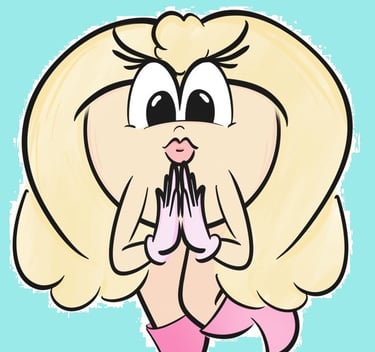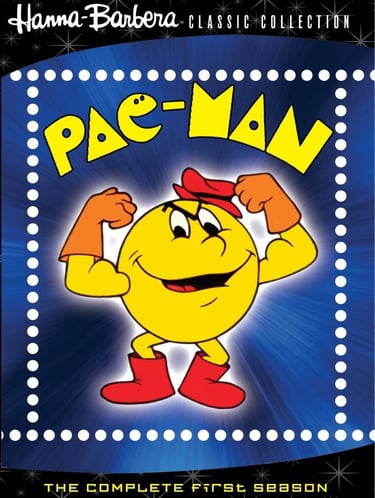Pac-Man: The Complete First Season
1982-1983, Developed: Jeffrey Scott, Produced: Kay Wright and Iwao Takamoto, Composed: Hoyt Curtin
Few video game characters receive the same reverence as Pac-Man. And for good reason—without the globular dot-muncher, early gaming would have lacked a certain personality—a friendly face—with which to attract the masses. Pac-Man made the pastime approachable to the average passerby, to the Joe or Jody not particularly smitten with spaceships and aliens and rectangular race cars. Pac-Man gave the art form its first flicker of a soul.
The yella fella soon became a sensation, the first pixel-art star that would rule the gaming scene while simultaneously transcending it, dominating everything from lunch boxes and vinyl records to toys, trinkets, and board games. Pac’s greatest accomplishment, however, might have been his cartoon show--a somewhat odd box of parts cobbled courtesy of Hanna-Barbera Productions. It was the first of its kind--an animated series based on a video game--and the results are often mocked for the derivative plotlines and low-budget proceedings.
But, in fairness, most cartoons of the era were guilty of such sins, sporting chintzy animation, rudimentary artwork, and recycled assets—handicraft with an often processed, assembly-line feel. Hanna-Barbera was king of creating this kind of slick, budgeted schtick. Indeed, "the disposable show" had become an industry-wide philosophy.
So the Pac-Man cartoon, in this sense, should have been bad. Akin, perhaps, to a reskinned Snorks repurposed just enough to trick the kids and snag some quick-ratings cash. But that’s not what happened, not exactly. Although hardly the epitome of excellence, Pac’s TV show became something of a miracle, somehow converting an incredibly abstract video game featuring a nondescript disc into something recognizable. Relatable. Real. And all courtesy of a middling cartoon company far removed from the world of video games, and certainly of Pac-Man's early, probably non-existent lore.
What this means is that, from virtually nothing, Hanna-Barbera had to repurpose—nay, recreate—Pac-Man for a 3-D space. Give him a voice. A persona. Goals, quirks, strengths, and weaknesses. A family. A home. Hopes and setbacks and a believable world filled with its own saints and villains. It must have been a real challenge...a fact which makes the product all the more astounding in its final, still very watchable form.
Below is an overview/dissection of the quasi-pilot episode Presidential Pac-Nappers. This roughly 11-minute short goes to great lengths in introducing a decidedly revamped version of the hero, giving the puck both a shape and a soul—not unlike how Pac granted video games the same disarming spark of accessibility. Where the game offered abstract lines of blue crisscrossing a sea of black, the cartoon bestowed the hero with a colorful, fanciful world. A loving family. A job. And an ensemble of deliciously wacky villains to constantly thwart. Good cartoon or not, this is the Pac-Man people still tend to imagine. That creator Namco still perpetuates to this day.
And, seriously, how can anyone resist that supremely genius theme song?--D
Pac-Man Episode 1: Dissection and Discussion
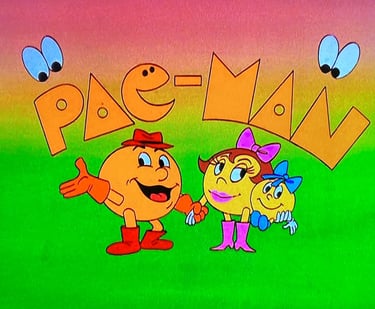

The DVDs for Season One and Two are available conveniently at Amazon.
The intro card for every two-episode show tailing the catchy musical opening theme. The dynamic trio as shown: Pac, Ma'am, and Baby.
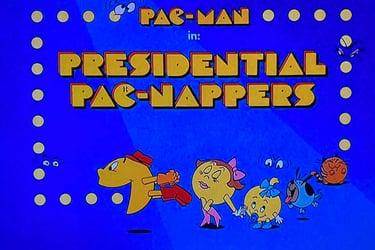


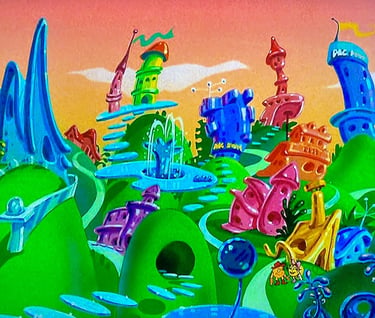
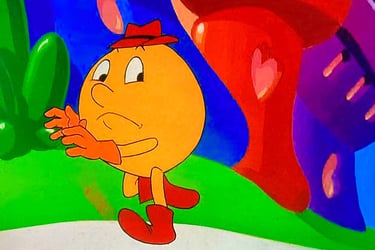

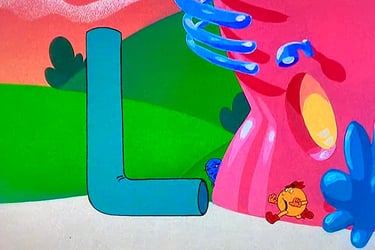

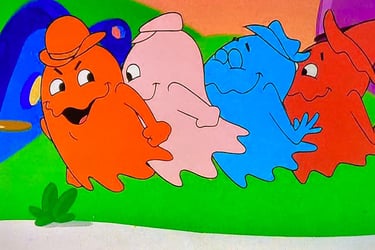

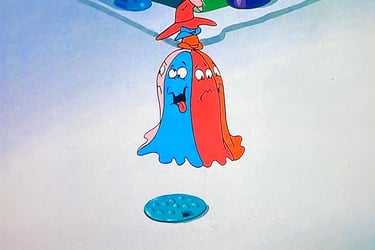

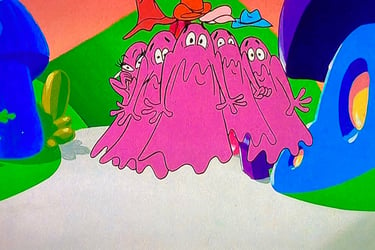

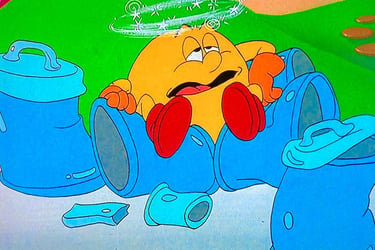

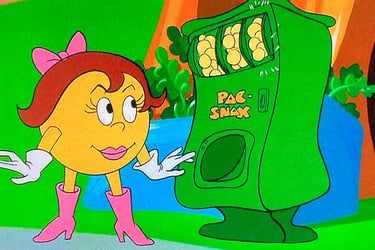

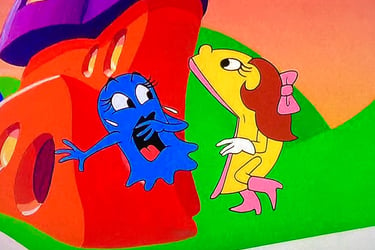

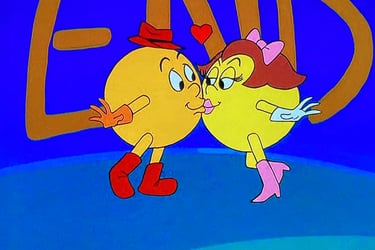

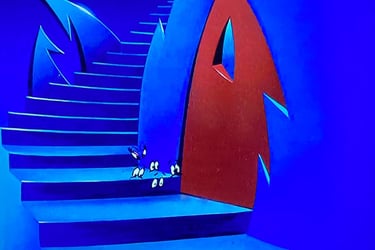

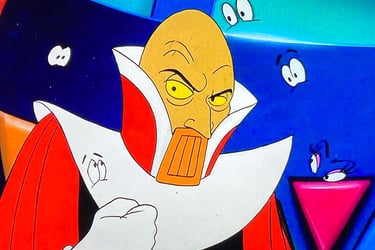

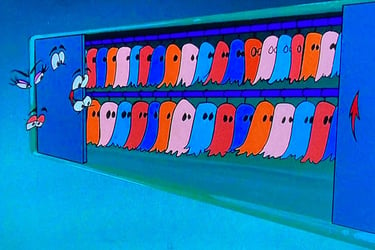

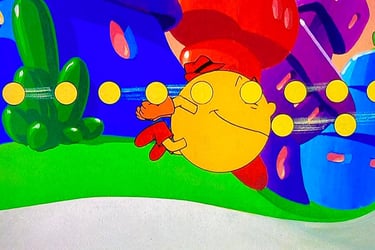


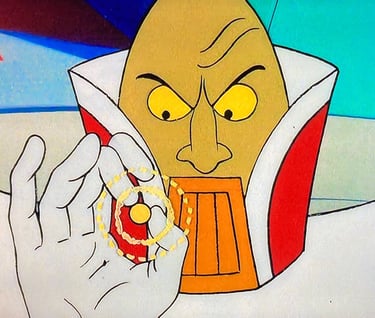
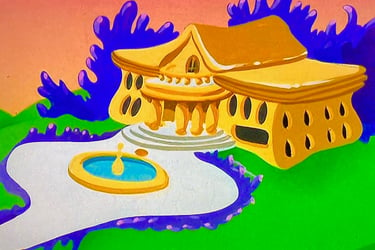

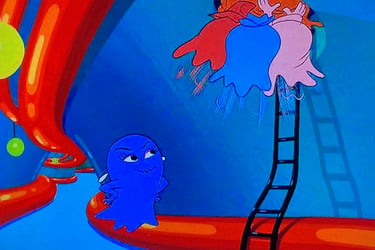




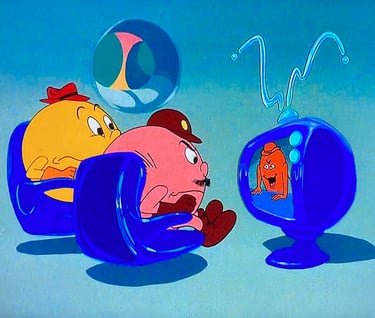
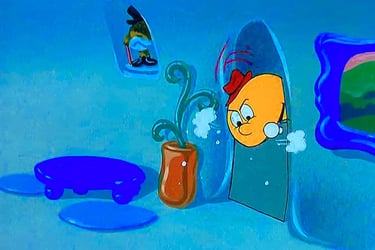

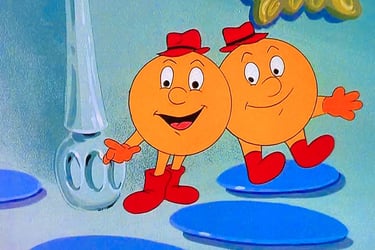

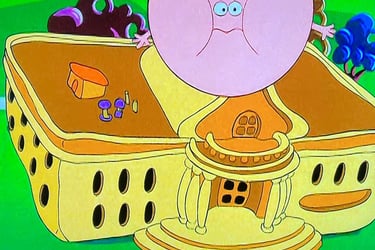

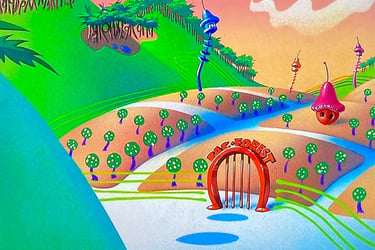

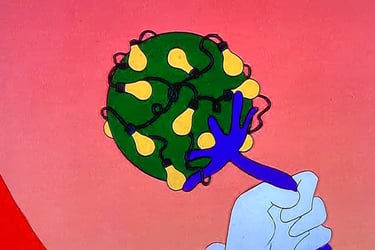


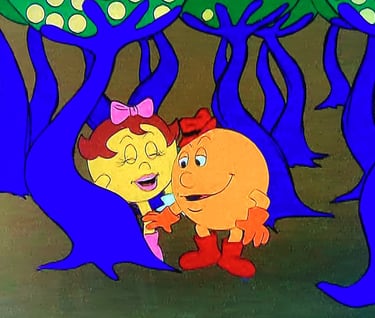

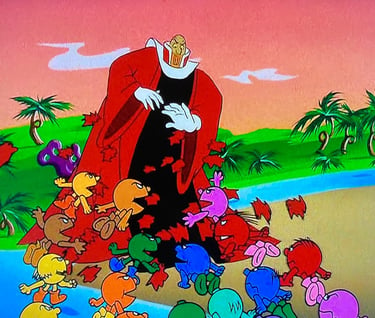

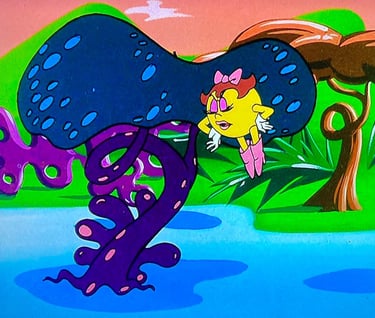

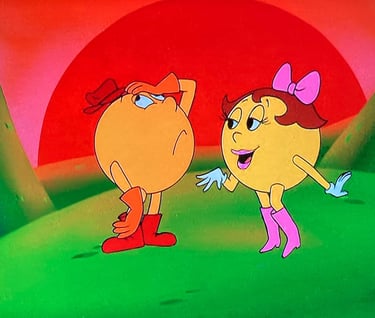
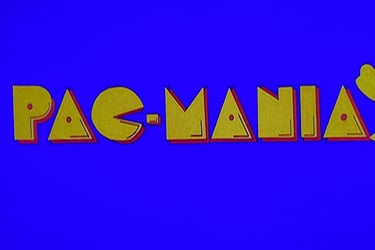

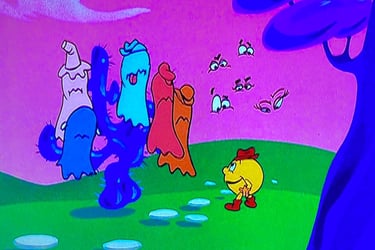

The episode's title card. Note Pac-Baby, Chomp-Chomp the dog, and Sour Puss the cat; they don't appear in this episode.
An opening pan of Pac-Land - considering the game's austere sensibilities, this lush (and psychedelic) take on Pac's world is rather stunning (and surprising).
The scene begins with the series' first look at Pac-Man, running for his life. Note more of that hyper-stylized, ostentatious scenery in the background. Are those windows carved in the shape of hearts?
Left to right: Clyde, Pinky, Inky, and Blinky, coined here as "ghost monsters." Before now, the ghosts' classification wasn't known, with the games often referring to them simply as "monsters." Here, Hanna-Barbera splits the difference.
A fifth ghost, "Sue," makes her first appearance, inexplicably setting a pipe in Pac's path. Unable to stop, Pac goes through the tube and launches himself skyward. (Sue was first seen in Ms. Pac-Man, replacing Clyde.)
Sue's pipe, oddly, fools Pac's pursuers as well, causing them to clash in a splashy mashing. The animators have fun depicting the villains' "squishiness" throughout the series.
Pac finally lands, now vulnerable to the ghosts...
...only to be saved by his lovely wife, Pepper (Ms. Pac-Man). One wonders how her first name was devised, but it somehow fits. The missus certainly has plenty of 'pep' in her step.
The vending machine conveniently launches a volley of "power pellets," which are synonymous with the "energizers" so crucial to survival in the games. The alliterative moniker would be retained in future Pac media, becoming the canonical term.
Munching the pellets turns the ghost blu--well, purple, per the cartoon. Same difference, though; the five bad guys are now supremely chompable.
Not to be outdone by her husband, Pepper gives Sue the bite of her life.
Fortunately, Pepper's lip hinges are much more measured when romance is concerned. The series does a commendable job depicting the love the two heroes share for each other.
Duly chomped and reduced to an even more minimalist, ethereal form, the five sets of eyes retreat back to headquarters...wherever that is.
Viewers are introduced to Mezmeron, a sort of Darth Vader wannabe. Nevertheless, he serves his purpose, providing an adequate mastermind/foil for the ghosts. Later Pac villains, such as the Ghost Witch, clearly took inspiration from his design.
One of the bigger mysteries of Pac-Man are those regenerative ghost chambers seen from the first game onward. The cartoon's writers get clever here, assuming the ghosts' "skin" is really a costume that allows them to interact with the physical world. It's weird, but...why not?
The Red Leader expounds on his ultimate desire--uncovering the location of the "Power Forest," the source of Pac-Land's energy. Clyde confirms that Pac's the security chief of this pivotal place. So, yeah, Pac-Man is more than just a guy who likes gobbling dots.
To force Pac into divulging the "hidden" forest's whereabouts, the ghosts intend to pacnap the President. And yes, he resides at the so-called Yellow House.
Being ever-so sneaky, the ghosts penetrate the House's defenses by coming in from the sewers. Sue, ever the lady, lets the guys force their way in first.
In the games, getting nabbed by a ghost meant a melty, imploding hero. Here, a ghost bite just seems to severely fatigue the victim, as seen with the just-nipped, pacnapped president.
Pac, watching TV with his boss at security headquarters, learns of the president's predicament via the ghosts' breaching of the airwaves. It's up to him, only him, to save the big cheese.
Pac arrives at the Yellow House, finding it very blue inside. He always knew how to make an entrance...
Pac brings an inflatable decoy (instead of power pellets?!) that momentarily distracts the ghosts, but seems to ultimately fail in solving the problem at hand--rescuing the president.
Kirby? Actually, it's Pinky doing the puffball thing long before Kirby was even a dream. Here, he lifts the Yellow House from its foundation with Pac and the President still inside.
Having no choice, Pac is seemingly forced to divulge the location of the Power, er, Pac-Forest here.
Of course, it's a trick, that wacky Pac-Man having matters under control all along. Mezmeron's been had!
Ever the devoted wife, Pepper returns to help out, bringing a stash of fresh power pellets with her. The two scamps laugh before scarfing down the ghosts.
Now out and vulnerable, Mezmeron gets nibbled by a racially-diverse pack of pac-people who dive out from nowhere. The red baron flees, presumably to his (secret?) lair.
Coincidentally, eating a Power Pellet apparently provides the gift of flight, as seen repeatedly in the series. Pepper is currently scolding her prey: "This'll teach you to mess around with my Packy." What a goil!
The day won, Pac bemoans another Power Pellet-based dinner awaiting at home. Pepper's just glad he's safe. FIN
Episodes are sometimes bridged with brief "Pac-Mania" segments, which are the equivalent to an animated comic strip gag (or like the later Garfield and Friends "quickies"). Namco, the owner of Pac-Man, would release Pac-Mania in 1987; did the company take the title from these animated, interstitial bits?
In this specific short, Pac-Man uses some quick-grow cactus seeds to snag the ghosts in their tracks, reemphasizing their ephemeral, "suited" nature.
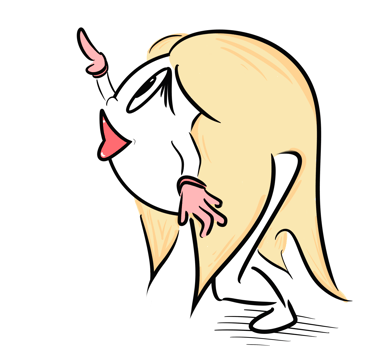

She seems really familiar...


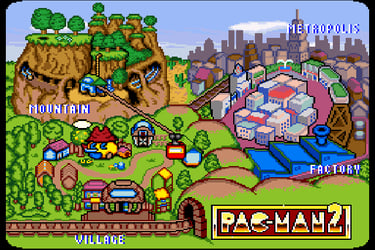

Left (or Below): Pac was voiced by the illustrious Marty Ingels. It was an essential choice in imbuing Pac-Man, a literally one-dimensional character, with a likable persona. Above: Later games would obviously be inspired by, or outright crib from, the cartoon world Hanna-Barbera first devised. Pac-Man 2, for instance, sports a suburb and cast of characters very much in keeping with the cartoon (but with humans as the now apparently dominate species). Thanks to StrategyWiki.org for the pic!
Contact: lostnostalgiaproductions@gmail.com
Website: www.lostnostalgia.com
Like what we're doing? Please consider throwing us a dollar into our Patreon page's tip jar!
